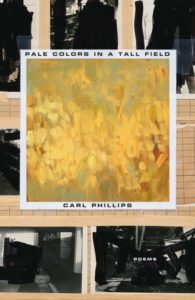Carl Phillips invites you to a dream
You read the poems in Pale Colors in a Tall Field by Carl Phillips. And you quickly gain the sense of walking into a dream. A vivid dream might happen in vivid colors, crowding out other, paler events and memories. But as Phillips suggests in his poems, those paler images are important, too. In their own way, even as they might recede, they shape not only what we dream, but who we are and how we live.
That’s the soul of this collection, a dream journey into memory reality, and identity. Phillips works the soft whites, the pale blues, and the light greens, the colors we might often forget but also the ones that make possible what comes after.
It’s difficult to select one favorite poem from this collection. It’s a slender volume of 34 poems, poems that seem deceptively quiet and thoughtful but also can pack a punch.
For Nothing Tender About It

then is this desire, the cloak of shadows,
that I wrap around me, that I
refuse to take off?
But the lake looks endless.
And my boat’s increasingly but a slowish swimmer,
Across the waves—I’ve known
Hurt, I mean; and I have been afraid. Sometimes
the difference between forgetting
to bring along artillery and showing up
on purpose to the war unarmed
is just that: a difference. Sometimes a lost tune,
unreckoned on, unearned, resurfaces anyway. Just because.
Am I not the animal by belief alone I myself make possible?
The poem begins by asking a question. Memory is formed by shame and desire, he says, and is the poet wrapping himself, cloaking himself in memory almost defiantly, a cloak he refuses to discard? It then shifts to the metaphor of the lake, a more contained (and calm) body of water than the sea, with the boat slowing, possibly with age, in the waters that are a reminder of hurt and fear.

Carl Phillips
And then it shifts to a military image, the artillery one brings to war forgotten, and shifts again to the meaning of a lost tune or song suddenly resurfacing. The thoughts and images tumble successively but not haphazardly, as the poet reaches a final statement of self-definition and identity.
Phillips has published several previous volumes of poetry, including The Rest of Love and Speak Low, both National Book Award finalists. He’s also published works of criticism and translation: The Art of Daring: Risk, Restlessness, and Imagination, and Coin of the Realm: Essay on the Life and Art of Poetry. In 2003, he published a translation of Philoctetes by Sophocles. He’s received fellowships from the Guggenheim Foundation, the Academy of American Poets, and the Library of Congress, as well as several literary awards and prizes. He is a professor of English at Washington University in St. Louis.
The poems of Pale Colors in a Tall Field invite you into a dream, but be forewarned. The dream will raise unexpected and important questions, questions that, if pursued, will lead to doubt, clarity, wonder, and understanding.
Photo by Adam Selwood, Creative Commons, via Flickr. Post by Glynn Young.
How to Read a Poem uses images like the mouse, the hive, the switch (from the Billy Collins poem)—to guide readers into new ways of understanding poems. Anthology included.
“I require all our incoming poetry students—in the MFA I direct—to buy and read this book.”
—Jeanetta Calhoun Mish
- Poets and Poems: Autumn Williams and “Clouds on the Ground” - November 20, 2025
- The Manuscript of “The Waste Land” by T.S. Eliot - November 18, 2025
- “The Summer We Crossed Europe in the Rain” by Kazuo Ishiguro - November 13, 2025


Leave a Reply